ALGEBRA (SÁINZ SÁNCHEZ, MIGUEL ÁNGEL)
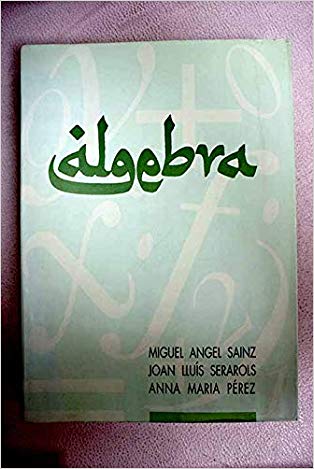
UNA CLASE DE FUNCIONES GENERALIZADAS EN ÁLGEBRAS LOCALMENTE CONVEXAS DE INVERSIÓN CONTÍNUA (PÉREZ GONZÁLEZ, FERNANDO)

ALGORITMOS EN GRAFOS Y REDES (CON. DISKETTE) (PELEGRÍN PELEGRÍN, BLAS/CÁNOVAS, LÁZARO/FERNÁNDEZ, PASCUAL)
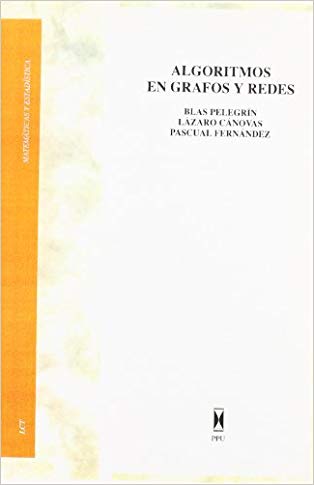
INTRODUCCIÓN A LA TEORÍA DE GRUPOS (ZALDIVAR, FELIPE)
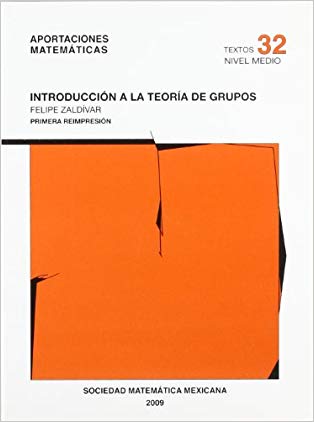 Desde la geometría hasta la física, desde la combinatoria hasta la teoría de números, dondequiera que existan simetrías, la teoría de grupos está presente. Este libro es una introducción a la teoría de grupos, y a pesar que sólo es una introducción elemental, toca muchos aspectos de la teoría, con un énfasis en los grupos finitos, preparando al estudiantes para niveles más avanzados. Los prerrequisitos para leer este libro se han mantenido a un mínimo: un curso de Algebra Lineal y un curso de matemáticas finitas que incluya algo de divisibilidad de enteros, números primos y el teorema fundamental de la aritmética. El libro comienza con un intento de describir el concepto de simetría para motivar la idea de grupo y después de discutir algunos ejemplos importantes, grupos cíclicos, de permutaciones y de matrices, introduce los teoremas de estructura básicos, desde el teorema de Lagrange hasta los teoremas de Sylow, y luego los aplica para dar una introducción elemental al estudio de los grupos simples y solubles.
Desde la geometría hasta la física, desde la combinatoria hasta la teoría de números, dondequiera que existan simetrías, la teoría de grupos está presente. Este libro es una introducción a la teoría de grupos, y a pesar que sólo es una introducción elemental, toca muchos aspectos de la teoría, con un énfasis en los grupos finitos, preparando al estudiantes para niveles más avanzados. Los prerrequisitos para leer este libro se han mantenido a un mínimo: un curso de Algebra Lineal y un curso de matemáticas finitas que incluya algo de divisibilidad de enteros, números primos y el teorema fundamental de la aritmética. El libro comienza con un intento de describir el concepto de simetría para motivar la idea de grupo y después de discutir algunos ejemplos importantes, grupos cíclicos, de permutaciones y de matrices, introduce los teoremas de estructura básicos, desde el teorema de Lagrange hasta los teoremas de Sylow, y luego los aplica para dar una introducción elemental al estudio de los grupos simples y solubles.ÁLGEBRA FINITA Y LINEAL . 86 PROBLEMAS ÚTILES (BURGOS, JUAN DE)
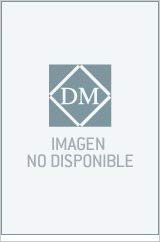
TABLAS DE LOS LOGARITMOS VULGARES Y DE LAS LÍNEAS TRIGONOMÉTRICAS (VÁZQUEZ QUEIPO, VICENTE)
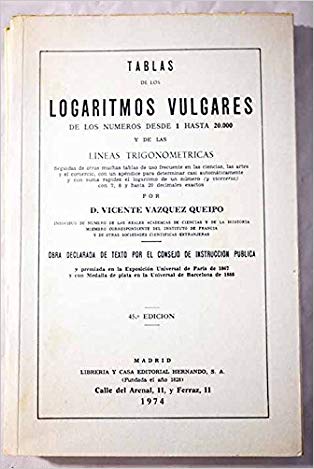
INTERMEDIATE ALGEBRA (FREMPONG, A. A.)
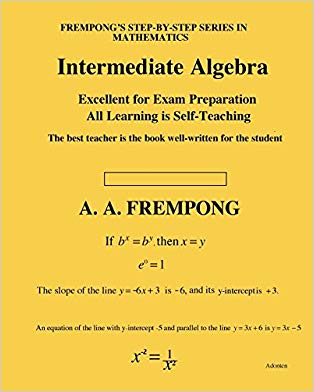 Intermediate Algebra is a very user-friendly mathematics book, and covers the following topics: real number operations; exponents ; radicals; fractional exponents; factoring polynomials; solving quadratic equations and applications; graphs, slopes, intercepts, and equations of straight lines; graphs of parabolas; linear inequalities; compound inequalities; inequality word problems; reduction, multiplication, division, and addition of algebraic fractions; solving fractional or rational equations; solving radical equations; variation and variation problems. complex numbers; square roots of negative numbers; addition, multiplication and division of complex numbers; absolute value equations; absolute value inequalities; logarithms; logarithmic equations and exponential equations; graphs of exponential and logarithmic functions; applications of exponential and logarithmic functions; one-to-one functions; composite functions, inverse functions and inverse relations.
Intermediate Algebra is a very user-friendly mathematics book, and covers the following topics: real number operations; exponents ; radicals; fractional exponents; factoring polynomials; solving quadratic equations and applications; graphs, slopes, intercepts, and equations of straight lines; graphs of parabolas; linear inequalities; compound inequalities; inequality word problems; reduction, multiplication, division, and addition of algebraic fractions; solving fractional or rational equations; solving radical equations; variation and variation problems. complex numbers; square roots of negative numbers; addition, multiplication and division of complex numbers; absolute value equations; absolute value inequalities; logarithms; logarithmic equations and exponential equations; graphs of exponential and logarithmic functions; applications of exponential and logarithmic functions; one-to-one functions; composite functions, inverse functions and inverse relations.ANDANZAS Y AVENTURAS DE LAS ECUACIONES CÚBICA Y CUÁRTICA A SU PASO POR ESPAÑA . UN CAPÍTULO DE LA HISTORIA DEL ÁLGEBRA ESPAÑOLA (MORENO CASTILLO, RICARDO)

PROBLEMAS DE ÁLGEBRA CON ESQUEMAS TEÓRICOS (VILLA CUENCA, AGUSTÍN DE LA)
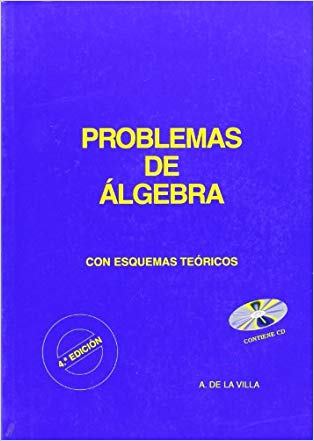
COLLEGE ALGEBRA (ABRAMSON, JAY)
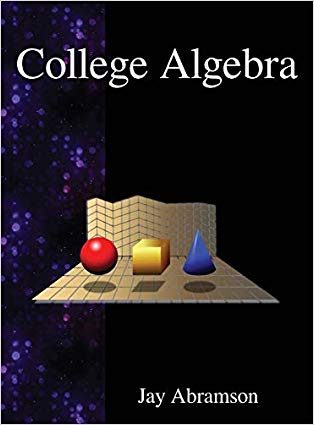 College Algebra provides a comprehensive exploration of algebraic principles and meets scope and sequence requirements for a typical introductory algebra course. The modular approach and richness of content ensure that the book meets the needs of a variety of courses. College Algebra offers a wealth of examples with detailed, conceptual explanations, building a strong foundation in the material before asking students to apply what they?ve learned. Coverage and Scope In determining the concepts, skills, and topics to cover, we engaged dozens of highly experienced instructors with a range of student audiences. The resulting scope and sequence proceeds logically while allowing for a significant amount of flexibility in instruction. Chapters 1 and 2 provide both a review and foundation for study of Functions that begins in Chapter 3. The authors recognize that while some institutions may find this material a prerequisite, other institutions have told us that they have a cohort that need the prerequisite skills built into the course. Chapter 1: Prerequisites Chapter 2: Equations and Inequalities Chapters 3-6: Th
College Algebra provides a comprehensive exploration of algebraic principles and meets scope and sequence requirements for a typical introductory algebra course. The modular approach and richness of content ensure that the book meets the needs of a variety of courses. College Algebra offers a wealth of examples with detailed, conceptual explanations, building a strong foundation in the material before asking students to apply what they?ve learned. Coverage and Scope In determining the concepts, skills, and topics to cover, we engaged dozens of highly experienced instructors with a range of student audiences. The resulting scope and sequence proceeds logically while allowing for a significant amount of flexibility in instruction. Chapters 1 and 2 provide both a review and foundation for study of Functions that begins in Chapter 3. The authors recognize that while some institutions may find this material a prerequisite, other institutions have told us that they have a cohort that need the prerequisite skills built into the course. Chapter 1: Prerequisites Chapter 2: Equations and Inequalities Chapters 3-6: ThPROBLEMES DÀLGEBRA . QUADERN DE TÈCNIQUES I MITJANS – NÚM. 1 (RIERA MADURELL, TERESA / ROCA SALOM, PILAR)
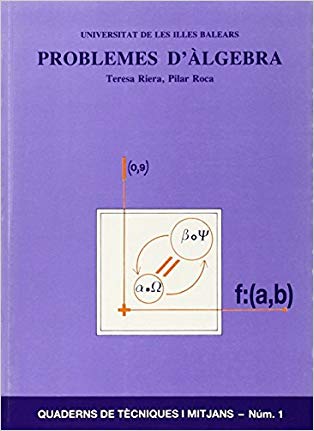 Conjunto de problemas y ejercicios de álgebra pensado pora que sirva de ayuda a los estudiantes de primer curso de álgebra de nievll universitario a aplicar los conocimientos teóricos a la resolución de problemas prácticos para llegar a una mejor comprensión de los conceptos.
Conjunto de problemas y ejercicios de álgebra pensado pora que sirva de ayuda a los estudiantes de primer curso de álgebra de nievll universitario a aplicar los conocimientos teóricos a la resolución de problemas prácticos para llegar a una mejor comprensión de los conceptos.ÀLGEBRA MATRICIAL: SISTEMES D?EQUACIONS (CASSÚ, CARLES)
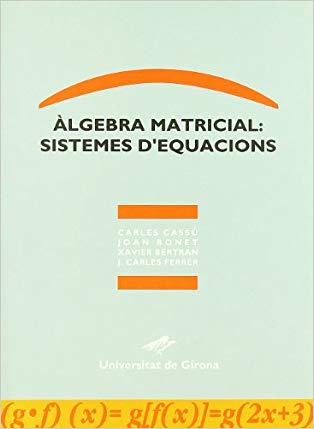 "En aquest volum utilitzem bona part dels conceptes matrius i determinats. Es comença definint la terminologia bàsica dels sistemes, utilizant la nomenclatura i els conceptes apresos en els volums anteriors. A partir del concepte de rang d'una matriu es dedueix l'important teorema de Rouché-Froebius en el qual s'analittzen les condicions perquè un sistema sigui compatible, i a continuació s'introdueixen els principals mètodes de resolució de sistemes d'equacions lineals. Finalment, es fa un breu estudi dels sistemes d'equacions no lineals, i dels sistemes d'equacions diofàntiques, que són aquells en què només té sentit considerar les solucions enteres de les incògnites."
"En aquest volum utilitzem bona part dels conceptes matrius i determinats. Es comença definint la terminologia bàsica dels sistemes, utilizant la nomenclatura i els conceptes apresos en els volums anteriors. A partir del concepte de rang d'una matriu es dedueix l'important teorema de Rouché-Froebius en el qual s'analittzen les condicions perquè un sistema sigui compatible, i a continuació s'introdueixen els principals mètodes de resolució de sistemes d'equacions lineals. Finalment, es fa un breu estudi dels sistemes d'equacions no lineals, i dels sistemes d'equacions diofàntiques, que són aquells en què només té sentit considerar les solucions enteres de les incògnites."

